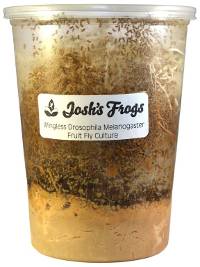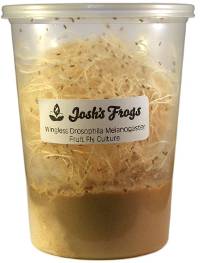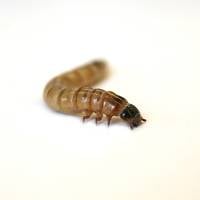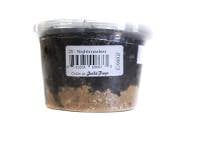Josh's Frogs
Why you should buy from us
Gold Mystery Snail - Pomacea bridgesii (Tank Raised)
Gold Mystery Snail - Pomacea bridgesii (Tank Raised)
$4.99 0.0 out of 5 stars
(0)
0.0 out of 5 stars
(0)About This Product
Characteristics:
- Large/colorful invertebrate
- Plant safe
- Easy to breed
- Easy to limit population growth
- Scavenger/bottom feeder
Name: Gold Mystery snail, or Pomacea bridgesii. This is one of many color variants of mystery snail. The origin of the common name? It is thought that because this snail was unidentified when it was first imported that it was simply called “mystery snail.” Although we now know the species (it is generally accepted that mystery snails are either “bridgesii” or “diffusa”), the common name has stuck.
Recommended Enclosure Size: The minimum aquarium size for one or more mystery snails is five gallons. The larger the aquarium, the more you can keep.
Temperature: Mystery snails are not fussy about temperature. They can thrive anywhere between 65-80 degrees fahrenheit, which makes them suitable for most tropical freshwater aquariums.
pH/Hardness: Mystery snails tend to fare better in moderate to hard water. Water that is too acidic can damage their shells. Consequently, they require some general hardness in their water to build their shells properly. A pH of 7.0-8.0 is considered ideal.
Size: At the time of sale, gold mystery snails will be at least 1-1.5” in size. Mystery snails can get up to 2” in size as adults. This is the shell diameter when full grown, and applies to both male and female snails. Females may get slightly larger, but this is not usually very obvious.
Age: At time of purchase, gold mystery snails will be at least two months old. These snails can live 1-2 years under ideal conditions.
Feeding: Mystery snails are grazers and will sample almost any food dropped in the aquarium. However, it is important to make sure they are getting the correct diet and not just left to fend for themselves. They appreciate offerings of all kinds of veggies and algae based foods. The addition of calcium in their diet is essential to keep their shells healthy (this can be calcium powder added to a gel diet like Repashy soilent green or a homemade “snello” recipe). Just be sure that whatever you feed them is eaten within a few hours and does not soil the water! Adding a cuttlebone can also be beneficial for a calcium source.
Sexing: Mystery snails cannot be reliably sexed by color, size, or other visual indicators. They also can change sex depending on environmental factors, meaning even if you determine one snail to be female at one point in time, that same snail can become male later in life and vice versa. The best way to determine sex is by close inspection. Sometimes males can be determined by the presence of a sheath near the gills. This is where the male copulatory organ is located. Females will not have this “sheath.” Due to their age and difficulty of sexing them, gold mystery snails sold by Josh’s Frogs are sold as unsexed animals.
Color/Pattern: Gold mystery snails are distinguished from other mystery snail varieties by having a bright yellow shell accompanied by a light cream colored body.
Social Behavior: Mystery snails are peaceful and fairly social. They get along well with their own kind. That being said, they do just fine on their own, too. They will not harm any other fish or shrimp tank mates. However, they can be harmed by some tank mates, such as larger cichlids, loaches, and other predatory animals. They are generally considered “plant safe”, unlike other large snail species.
Breeding: Mystery snails are not hermaphroditic, which means a male and female must be present for them to breed. Typically, when mating you can see the male on top of the female. Breeding happens almost without prompting in most situations if you have multiple snails. In order to get eggs and successful offspring, you will need to lower the water level a few inches to allow the female to lay her egg sac just above the water level. If kept adequately humid/moist, baby snails should hatch out of the egg sac within 2-3 weeks. What is nice with this snail is that if breeding is not desired, you can simply remove the egg sac and freeze then discard it to prevent population growth in your aquarium.
Natural Range: Pomacea bridgesii are native to South America and can be found throughout Brazil, Bolivia, and Paraguay. They have also been introduced in other areas, although not considered nearly as invasive as other apple snails in the genus (Pomacea maculata, P. canaliculata, etc.). Still, the need to keep aquarium specimens indoors cannot be overstated. Never introduce any of your aquarium inhabitants to natural bodies of water.
History in the Hobby: Mystery snails have been in the hobby for many decades. They are now among the most popular snail pets in aquarium keeping, being available in many varieties and bred captively in large numbers. Though their origins and taxonomy are hotly debated, they are sure to be a mainstay in freshwater aquariums for decades to come.
Links of Interest:
https://en.wikipedia.org/wiki/Pomacea_bridgesii
https://aquariumbreeder.com/mystery-snail-detailed-guide-care-diet-and-breeding/
Still not sure if GOLD MYSTERY SNAIL from Josh's Frogs is the right pet for you? Read the reviews below and see what other customers are saying!
Shipping
This product ships to your doorstep. Most orders placed before 2pm ET on business days will ship out the same day.
Other Customers Also Bought
Customer Reviews
0.0 out of 5 stars
Review data
5 star reviews
- 0%
4 star reviews
- 0%
3 star reviews
- 0%
2 star reviews
- 0%
1 star reviews
- 0%








